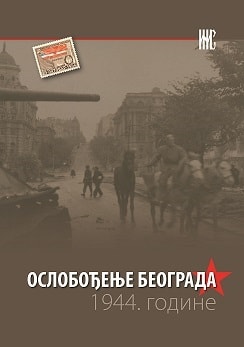Четници и Црвена армија у Србији 1944. године
The Chetniks and the Red Army in Serbia in 1944
Author(s): Žarko Jovanović
Subject(s): Military history, Political history, WW II and following years (1940 - 1949), Fascism, Nazism and WW II
Published by: Institut za noviju istoriju Srbije
Keywords: Yugoslavia; Soviet Union; Serbia; Red Army; NOVJ; Chetniks; Draža Mihajlović;
Summary/Abstract: WWII was aproaching its end in fall 1944. Italy, member of the Axis had already capitualted. German armed forces suffered grave defeats both on Western and Eastern fronts. They were also forced to start withdrawing from Greece through the vallies of the Vardar and the Morava. The Chetnik movement of Dragoljub Draža Mihalović was also in bad shape at that time. After a number of admonitions to start military actions against the occupying forces, the Western Allies withdrew their military missions from the Staff of Supreme Command as well as from other Chetnik staffs. Furthermore, they withheld military and every other kind of aid. Under the pressure of the British government, the King and the Yugoslav exile government have given them up too. The increasingly difficult military and political situation of the movement of Dragoljub Draža Mihalović spurred the gathering of the Central Nationa Committee whose permanent session started in the village of Milićevci near Čačak on September 8, 1944. Apart from making combinations about the make-up of the „Chetnik government“, the possibility of the Russian crossing of the Danube into Serbia and Yugoslavia was discussed at the meeting. Having crossed the Yugoslav-Romanian border at Turnu Severin on September 6, 1944, the units of 3rd Ukrainian Front of the Red Army, together with the units of the People’s Liberation Army dispersed the German, Chetnik, Nedić and Ljotić forces and prepared to take starting positions for the begining of the Belgrade operation. On hearing that the Red Army units were crossing into Serbia and in order to butter up to the command of the Soviet troops, the commander of the Rasina-Toplica corps group colonel Dragutin Keserović immediately undertook sabotage actions, obstructing German transports and he started attacking German forces. He ordered that German lines of communication be severed between Vrnjačka Banja and Kraljevo. Part of the Toplica Corps was saddled with the task to do the same between the village of Stopanje and Trstenik. The third part of his forces had the task to cut off the communication between Kruševac and Stalać. Chetnik forces of over 10.000 soldiers were used for these actions. At the intervention of the leadership of the People’s Liberation Army of Yugoslavia, the attempt at cooperation between the Chetniks of Draža Mihalović and the Red Army units turned out to be a total failure since it was known that some Chetnik commanders continued colaborating with Germans. For the leadership of the Red Army the Chetniks became the enemy force in Serbia which was to be destroyed together with occupying and other Quisling forces. Part of the members of Chetnik units was disarmed and set free, whereas many joined the units of the People’s Liberation Army of Yugoslavia and took part in the fight against occupiers and their collaborators. The Chetnik forces which managed to avoid being disarmed, withdrew together with their commanders and the Supreme Command simultaneously with the occupying forces in the previously determined direction of Bosnia and further to the West where they met with tragic fate. Smaller Chetnik groups which remained in some parts of Serbia organized terrorist activities for some time after the end of WWII until they were completely destroyed.
Book: Ослобођење Београда 1944.
- Page Range: 133-146
- Page Count: 14
- Publication Year: 2010
- Language: Serbian
- Content File-PDF

